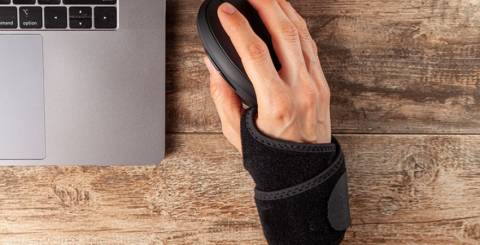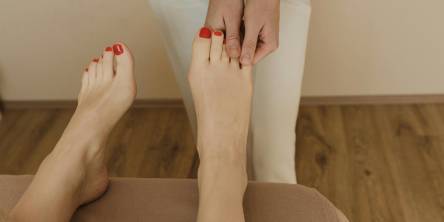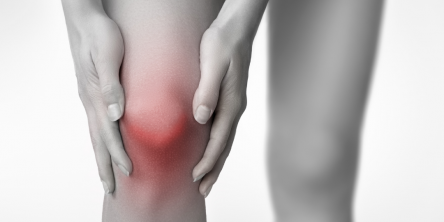6 Home Remedies to Fight Carpal Tunnel Syndrome

The carpal tunnel is a tiny corridor over the bones and ligaments on the palm side of your wrist. Carpal tunnel syndrome occurs when the median nerve, which passes through this channel to the thumb and first three fingers, is constantly under pressure.
Inflammation in the wrist is frequently caused by a medical disease that produces swelling, such as diabetes, thyroid problems, or an inflammatory ailment like rheumatoid arthritis. Another cause is fluid retention during pregnancy or menopause, as well as repetitive wrist movements.
Tendons flow through a thin tunnel over the carpal, or wrist bone, in a limited area like the wrist. When stressed cells produce lactic acid, which can bind the fibers together for protection, inflammation produces swelling. As a result, carpal tunnel syndrome can cause nerve injury.
1. Conventional therapies
The most frequent carpal tunnel treatments involve either immobilizing the affected area to prevent repetitive motions or surgically opening up the area to relieve pressure. However, according to a study published in the Journal of Orthopaedic & Sports Physical Treatment, physical therapy may be just as effective as surgery. The study tracked 100 women with the illness from Madrid; half of them were treated with physical therapy and the other half with surgery.
Researchers discovered that physical treatment (specifically, manual therapy) enhanced hand and wrist function and reduced discomfort just as well as a typical operation for the ailment. Furthermore, after one month, patients who had physical therapy reported greater improvements than those who received surgery.
2. Treating with cold and vibration
You've certainly heard that cooling the inflamed area can help with carpal tunnel syndrome, but Baxter warns that this stiffens muscles and tendons and restricts blood flow. Massage the affected area after icing to increase blood flow. The massage keeps the muscle fibers pliable, which reduces re-injury damage from moving fibers seeking to cling together to prevent movement and makes ice more pleasant.
3. Rest
Resting your fingers, hand, and wrist is the most basic carpal tunnel treatment. Stop any activities that you believe are producing numbness and pain. When the symptoms improve, the activity can be progressively resumed. Patients assess their home and work environments for ergonomic difficulties that may be contributing to their symptoms. Switching to an ergonomic keyboard or mouse, adjusting the position of the keyboard and mouse to allow the wrists to be in a neutral position, or utilizing a padded wrist rest may help ease symptoms. Patients at home could stretch and exercise their hands and wrists during breaks from repetitive duties.
4. Stretches
Simple wrist exercises can be done at any time of day, whether at your desk at work or while waiting in line at the store. To treat wrist pain, the American Academy of Orthopaedic Surgeons recommends creating a fist and then sliding your fingers until they are straight again, repeating the procedure five to ten times. If you suffer from fluid retention due to pregnancy or a fracture, make it a practice to elevate your hands and wrists whenever possible.
5. Nighttime splints
Maintaining straight wrists can help ease pressure on your median nerve. Because symptoms are more common at night, using a splint at night may help ease your symptoms before they begin. You can also use wrist splints during the day if you have problems with repeated duties at work.
The splint's objective is to retain the wrist in a neutral position, keeping the tunnel open and reducing nerve pressure. People often sleep with their wrists bent, which aggravate
s the pain. These splints can also be worn while participating in an activity that aggravates the discomfort.
6. Anti-inflammatory treatmentsMild cases may benefit from anti-inflammatory medications like ibuprofen or naproxen. Other anti-inflammatory methods, such as acupuncture and natural anti-inflammatory chemicals like turmeric and omega-3, have been found to aid some individuals with mild instances. However, if addressed, persistent or worsening symptoms such as continual burning or tingling, the advent of persistent numbness, or the onset of weakening might become permanent.
Similar Articles
Search engine optimization (SEO) may help physical therapists improve their online exposure and drive more visitors to their website.
You're sitting at home with two completely different treatment plans from two doctors you trust.
When conservative therapy fails, surgery may be required to alleviate chronic foot or ankle discomfort.
Your body changes with time - muscles and bones shift, ligaments loosen, and circulation may slow. Unfortunately, the aging process has an impact on our feet as well.
Back problems aren't just discomfort or temporary back pain. Many of them can be extremely dangerous and lead to serious complications if you don't seek medical attention on time.
Sciatica is a condition in which the sciatic nerve, the longest nerve in the human body, becomes irritated or pinched
Irritable bowel syndrome (IBS) is a dysfunction of the gastrointestinal tract that manifests as abdominal pain, bloating, flatulence, and intestinal discomfort (constipation, diarrhea, or a combination of both.
Peripheral neuropathy is when the nerves outside your brain and spinal cord—called peripheral nerves—aren’t working the way they should.
Ah, knees. Those underappreciated joints that heroically carry us up stairs, into dance battles, and through every questionable workout decision we make during a fitness phase.









